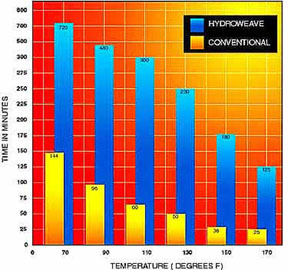|
Hydroweave®
can be used for a wide range of applications. These studies
detail various tests that have been performed on Hydroweave®.
Wear and Use Testing
AquaTex commissioned Auburn University to study the cooling
properties of Hydroweave®. The research project evaluated
how long Hydroweave® remains active and how effectively
it cools the wearer. Auburn University is a member of the
National Textile Center and conducts performance testing
on garments and their effects on the wearer under various
simulated work and stress conditions.
How long does it perform?
Cooling times vary with the application and the environment.
In environments where the qualities of active evaporation
can be realized, Hydroweave® can cool for hours. The
chart characterizes testing by Auburn University of Hydroweave®'s
evaporative cooling times to that of a conventional fabric
at varying temperatures from 70°F to 170°F (21~76º
C). In this test, Hydroweave® was shown to cool an outstanding
125 minutes (2 hours and 5 minutes) at 170°F.
Hydroweave® was also proven effective as a passive heat
sink for fully enclosed applications. In tests, vests made
from Hydroweave® were worn beneath poly-coated encapsulation
suits and proven as an effective deterrent to heat stress,
increasing work time by an average of 16.4%.

Expected performance of BodyTeq Apparel The cooling performance
of BodyTeq Apparel will depend on the following:
1. The length of time the Hydroweave® core absorbed
moisture.
Refer to Activation Procedure for specific products. Hydroweave
will absorb water for up to five minutes, but additional
time may be recommended if wicking is required to evenly
distribute moisture.
2. Humidity.
Higher humidity will slow evaporation, producing less cooling,
but over a longer duty cycle.
3. Temperature.
Higher air temperature will increase evaporation. On still
days, the initial sense of cooling may lessen as the body
adjusts to the cooling affect. However, the garment continues
to remove heat, and its contribution is dramatically felt
if the wearer moves into an air conditioned environment.
4. Wind speed over the garment.
Higher wind speed increases evaporation and cooling. On
motorcycles, vehicles, or bicycles, leather jackets or windbreakers
may be worn over the garments and opened to regulate cooling.
Based on these parameters, expect cooling from 1.5 hours
on a motorcycle or vehicle on a hot dry day, to as much
as 5 hours walking on a more humind day with less wind over
the garment.
How effective is Hydroweave®
when used under a barrier suit?
Used in a passive 'heat-sink' mode, Hydroweave® has
been proven to effectively reduce heat, maintain lower core
body temperature and increase worker productivity for up
to 16.4%....
read more

Cooler Fabrics For Protective
Apparel
For years, the apparel industry has focused on material
technology for fabrics that offered greater protection while
also becoming lighter, thinner, and more flexible....
read more

|

